Orchid Tree (Bauhinia): Purple, Pink, White and Hong Kong Orchid Trees
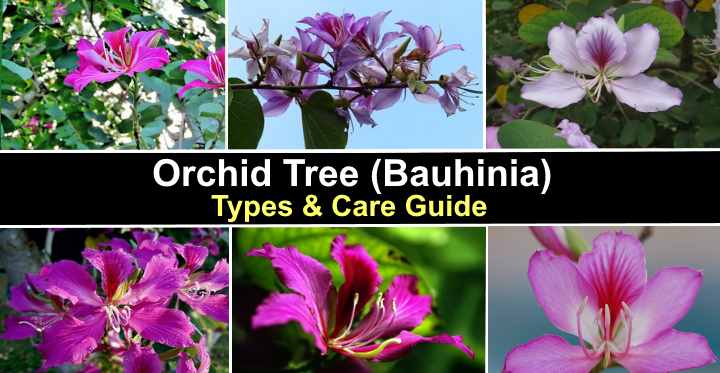
The orchid tree is a small, flowering, multi-stemmed tropical tree with beautiful pink, red, orange, yellow, white, or purple flowers resembling flowers growing on orchid plants. In addition, orchid trees have distinctive leathery, double-lobed green leaves that resemble the print of a cow’s hoof. Some species of orchid trees are evergreen trees. Still, others are deciduous trees that drop their leaves during the dry season or in winter.
This article is a guide to identifying the most common types of beautiful orchid trees. If you live in warm states such as south Texas, Florida, Hawaii, and southern California, you will also learn how to grow orchid trees in your garden landscape.
What Is Orchid Tree (Bauhinia)
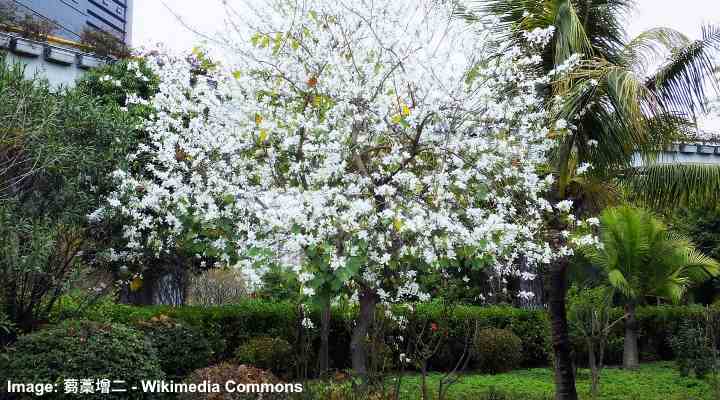
Orchid tree (Bauhinia)
The orchid tree is a genus of flowering shrubs and trees in the genus Bauhinia and the family Fabaceae. Orchid trees are native to Asia and commonly grow in India, China, Sri Lanka, and Vietnam. Some orchid tree species also grow in the wild in Texas in the Anacacho mountains, where they are known as Anacacho orchid tree or Texas Plume.
Orchid trees are fast-growing large tropical shrubs or trees that reach a height of 20 to 40 ft. (6 – 12 m) with a spread of 10 to 20 ft. (3 – 6 m). The trees are famous for their brightly colored orchid-like flowers that bloom in winter and persist until early summer.
Orchid trees thrive in the warm regions of USDA in zones 9 to 11.
After flowering, the tree develops long, flat brown seed pods, common of many trees in the pea family Fabaceae.
In colder climates, the green leafy foliage may drop from this semi-evergreen shrub-like tree. Although some varieties of orchid trees survive a light frost, they are generally heat-loving trees that thrive in full sun and moist soils. The minimum temperature to grow orchid trees is 22°F (-6°C).
Orchid Tree Flower
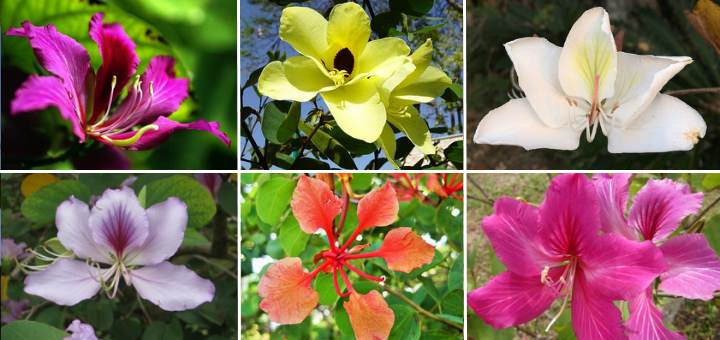
Orchid tree flowers can be pink, purple, red, yellow, orange, or white, depending on the species
Flowers on orchid trees are fragrant, colorful, showy blossoms that bloom abundantly from winter through early summer. The orchid-like pink, yellow, white, purple, and red flowers give off a delightful scent. Most orchid tree flowers have five petals and long arching stamens, creating spectacular tropical tree flowers.
Orchid tree flowers feature on the flag of Hong Kong. The so-called “Hong Kong flower” is a pinkish-purple, five-petaled flower of the Hong Kong orchid tree (Bauhinia blakeana). The orchid tree flower in the Hong Kong Flag is five white petals in a star shape.

Hong Kong Flag featuring Bauhinia blakeana flower
Orchid Tree Leaves
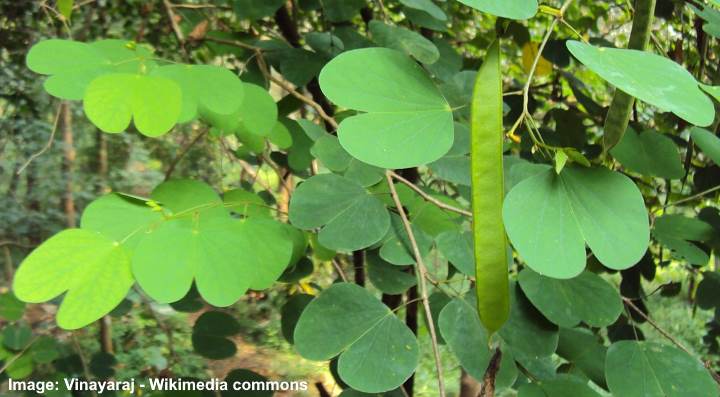
Bauhinia tomentosa (yellow bell orchid tree) leaves and seed pod
Orchid tree leaves are glossy, leathery heart-shaped leaves made up of two twin lobes. The orchid tree leaves are described as butterfly-like, and sometimes the two sides appear folded together on trees. The orchid tree leaf lobes generally have a rounded top and bottom.
Orchid Tree Care
To care for an orchid tree, grow the tree in full sun or part shade in moist, well-drained sandy soil. Water the orchid tree regularly during the summer. Fertilize the tree with compost in winter with potassium-rich fertilizer to encourage blooming in late winter. Prune twice a year before and after flowering.
Types of Orchid Tree (Bauhinia) with Pictures
Let’s look in more detail at the four common varieties of orchid trees that grow in warm sub-tropical and tropical climates.
Variegated Orchid Tree (Bauhinia variegata)
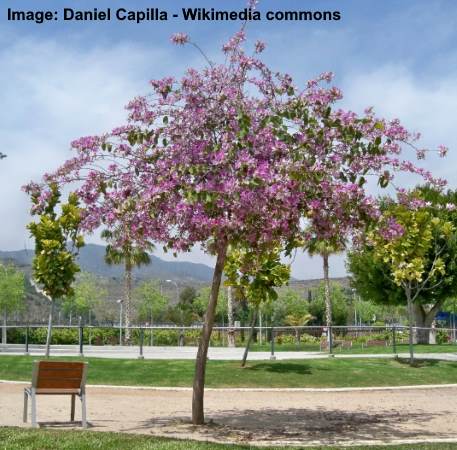
Variegated Orchid Tree (Bauhinia variegata)
The variegated orchid tree is a shrub-like tree with flamboyant five-petaled vibrantly colored pink, purple, and white flowers. Variegated orchid trees have an irregular crown consisting of broad bi-lobed, heart-shaped leaves. Ornamental variegated orchid trees grow 33 to 40 ft. (10 – 12 m) tall and wide.
Variegated orchid tree leaves are rounded leaves with the characteristic deep lobes at the base and apex. This feature gives the orchid tree leaves a heart shape, like two round butterfly wings. The leaves are 4” – 7” (10 – 20 cm) long and wide. As a semi-deciduous tree, leaves drop in the dry season.
Variegated orchid trees produce long bean-like seed pods that are 6” to 12” (15 – 30 cm) long. As the pods dry on the tree, they begin to twist, creating an unusual shape. The pods eventually crack open with an audible sound.
Other names for the variegated orchid tree include mountain ebony, purple orchid tree, and ebony wood.
Orchid Tree Flower

Bauhinia variegata flowers (on the right is Bauhinia variegata Candida)
Variegated orchid tree flowers are five-petaled white, pink, and purple orchid-like flowers. The five open petals have a papery texture with wavy edges, and a single flower can have multiple colors. Variegated orchid tree flowers measure 3” – 5” (7.5 – 13 cm) across.
Showy variegated orchid tree flowers blossom in clusters along the ends of stems. The orchid flowers give off a pleasant fragrance when in bloom—a characteristic trait of all orchid tree flowers.
Purple Orchid Tree (Bauhinia purpurea)

Purple orchid tree (Bauhinia purpurea) flowers and leaves
The purple orchid tree is a fast-growing multi-stemmed shrub-like tree with masses of spectacular purple flowers, heart-shaped leaves, and long brown seed pods. Purple orchid trees have a vase-shaped, symmetrical crown with moderate foliage density. As a type of fast-growing tree, a purple orchid tree matures at 30 to 35 ft. (9 – 10 m) tall and wide.
Purple orchid tree leaves are green matte heart-shaped leaves with a deep cleft or lob at the apex. In some leaves, the cleft reaches almost to the base, separating the two lobes of these tree leaves. Leaves grow alternately on purple orchid trees, measuring 2” to 4” (2.5 – 5 cm) long. They drop green in the fall rather than changing color.
The shrub-like tree has multiple stems. You can prune the orchid tree to create a spectacular specimen tree or lawn tree. However, the low-growing, drooping branches may mean that pruning is necessary to walk or drive under the tree.
Like all varieties of orchid trees, the purple variety has elongated brown seed pods. These 6” to 12” (15 – 30 cm) long pods harden on the tree before popping open to disperse the tiny seeds.
Orchid Tree Flower
Purple orchid tree flowers are showy purple or magenta pink flowers. Each flower has five showy petals with frilly margins, and the ends turn back like a showy orchid flower. The orchid tree flowers feature white veins, protruding stamens and deliver a delightful fragrance. Flowers are 3” to 5” (7.5 – 13 cm) in diameter.
An interesting feature of the purple orchid tree is that its flowers appear before the leaves drop. Then in fall, the tree’s leafless branches are covered in ornamental, showy purple flowers.
Hong Kong Orchid Tree (Bauhinia blakeana)
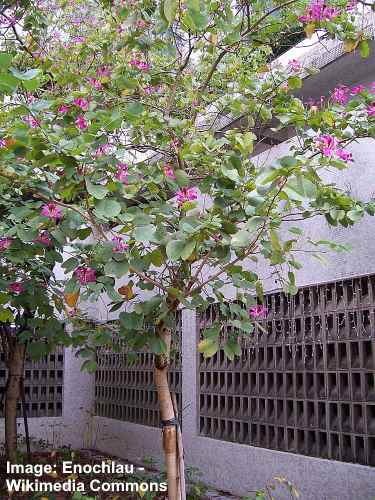
Hong Kong orchid tree (Bauhinia blakeana)
The Hong Kong orchid tree is a flowering shrub-like tree with showy orchid-like flowers, double-lobed butterfly-like leaves, no seed pods, and dark brown bark. The orchid tree has an irregular crown and matures at 12 to 20 ft. (3.6 – 6 m) tall and up to 25 ft. (7.6 m) wide.
Unlike other Bauhinia trees, the hybrid Hong Kong orchid tree doesn’t produce any seed pods. This makes the ornamental tree desirable for garden landscapes because there is no cleanup. With proper pruning, the multi-trunked orchid tree can grow as a specimen tree, flowering tree, or foundation planting.
Hong Kong orchid tree leaves are large, broadleaf evergreen blades with a spherical shape and a deep rounded cleft at the apex. The butterfly-like bi-lobed leaves measure 3” to 4” (7.5 – 13 cm) across and wide.
In some cultures, orchid tree leaves are said to bring good luck or are used as a symbol of wisdom.
Because the Hong Kong orchid tree is seedless, propagation is by stem cuttings, grafting, or air-layering.
Orchid Tree Flower
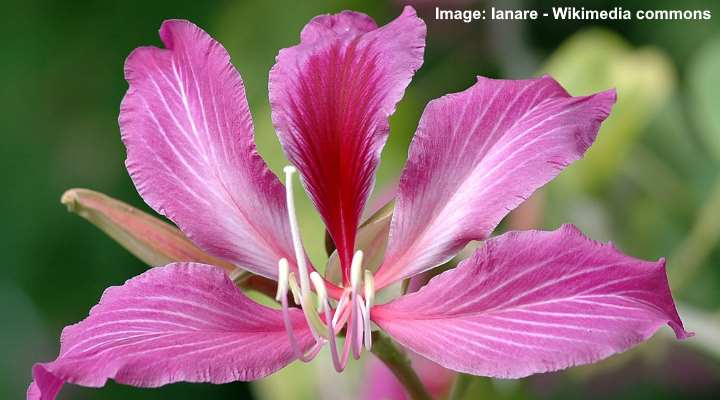
Bauhinia blakeana flower
Hong Kong orchid tree flowers are fragrant, flamboyant, showy blossoms that are pink or purple-lavender. Like most orchid trees, “Hong Kong flowers” have a long bloom season and grow en masse, covering the tree. The colorful five-petaled flowers measure 4” to 6” (10 – 15 cm) across.
In Hong Kong, there is a statue of a flowering orchid tree (Bauhinia blakeana). Although the orchid tree flowers are a vibrant pink, they appear on the Hong Kong flag as white on a red background.
Anacacho Orchid Tree or White Orchid Tree (Bauhinia lunarioides)
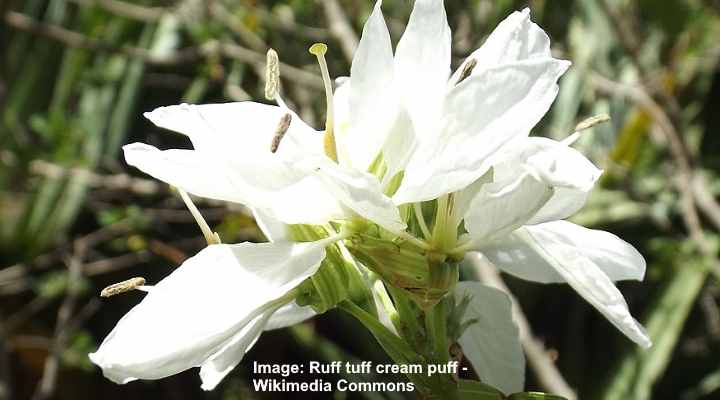
White orchid tree (Bauhinia lunarioides) flower
The white orchid tree is a small multi-stemmed shrub that you can grow as a tree. The beautiful ornamental orchid tree has snow-white orchid-like, five-petaled flowers growing in dense clusters that bloom during winter and spring. Thick, heart-shaped leathery leaves create moderately dense foliage, and the tree has silvery-gray bark.
Bauhinia lunarioides is native to Southwestern Texas and Northern Mexico. The white-flowering ornamental trees are known as Texas plume, Anacacho orchid tree, Mexican orchid tree, or Anacacho bauhinia.
Anacacho orchid trees grow 6 to 12 ft. (1.8 – 3.6 m) tall and up to 10 ft. (3 m) wide. The small shrub-like tree has an open, spreading, rounded crown.
White orchid tree leaves have the characteristic traits of all orchid tree varieties. The small, rounded twin-lobed, oval leaves measure 0.8” to 2” (2 – 5 cm) long and have a thick, leathery texture.
Orchid Tree Flower
Anacacho orchid tree flowers are showy, funnel-shaped orchid-like white (or rarely pink) flowers that bloom in spectacular clusters from late spring through summer. Like all orchid tree flowers, the Texas plume has fragrant blossoms that cover the tree when in bloom.
Planting an Orchid Tree
Orchid trees are generally easy to care for if you live in USDA zones 9 to 11. The orchid trees perform best when planted where there is protection from strong winds. Because Bauhinia is not salt-tolerant, they don’t grow well in coastal locations. Also, a young orchid tree needs staking to prevent the brittle stems from breaking.
To plant an orchid tree in your garden, dig a hole twice the size of the root ball. Ensure that the roots are pointing downward. The base of the trunk should be 1” (2.5 cm) above the soil line. Then, backfill the hole, making sure the tree is straight. Orchid trees require staking for the first three years until they become established.
Orchid trees are also suitable for growing in large containers. Choose a container two sizes larger than the root ball, ensuring there are plenty of drainage holes. Use a fertile, well-draining loamy potting mix. Place the potted orchid tree on your patio or deck where it gets full or partial sun. Water orchid tree in a pot whenever the top layer of soil is dry.
How to Care for Orchid Tree
Here are some handy tips on how to care for an orchid tree growing in your front or backyard.
The Right Location to Plant Orchid Tree
The best place in a garden to plant an orchid tree is in full sun, sandy or loamy, well-drained soil. The sun-loving trees will also perform well in partial shade. However, to ensure healthy growth and plenty of orchid-like blooms, orchid trees grow best with at least six hours of sunlight daily.
It’s important to note that orchid trees don’t tolerate harsh, freezing weather. Trees subject to regular light frosts (22°F or -6°C) may usually only grow as multi-stemmed shrubs. In winters, the semi-evergreen trees may lose their leaves and die back to the ground before returning the following spring.
How to Water Orchid Tree
Orchid trees perform best when they get occasional deep watering throughout the growing season. During scorching weather, water the flowering tree every ten days to keep the root system moist. In winter, you only need to water orchid trees occasionally to prevent the soil from drying out.
Orchid trees are relatively drought-tolerant once established. In addition, some varieties of orchid trees are native to dessert-like conditions. So, some dry spells won’t affect their growth too much.
Fertilizing Orchid Tree
Organic manure or compost in winter is usually enough to fertilize orchid trees and provide plenty of nutrients. However, some people recommend using a slow-release, granular fertilizer three times a year in spring, summer, and fall. Typically, older trees benefit from a high-potassium fertilizer to encourage healthy blooms.
Related reading: How to choose the best tree fertilizer.
Pruning Orchid Tree
Pruning an orchid tree is necessary to grow a specimen or lawn tree rather than a multi-trunk large shrub. This is because an orchid tree sends up suckers that need removing to create a single-stemmed tree. In addition, orchid tree branches tend to be weak and brittle and need pruning to help keep the tree’s shape.
The best time to prune an orchid tree is in late spring, after the tree finishes flowering. You can remove one-third to one-quarter of the branch length to keep the orchid tree healthy and encourage next season’s blooms.
Also, you should remove any branches growing across the tree’s canopy. This helps to maintain the orchid tree’s umbrella-shaped canopy. Generally, you can remove dead branches at any time of the year.
Propagating Orchid Tree
Orchid trees are easy to propagate by seed or semi-ripe stem cuttings.
You can collect orchid tree seeds when they burst open in summer. Allow them to dry before storing them in a cool place until the following spring. Before planting the seeds after the last frost, soak them for a few days. Place the seeds in moist soil, and they should germinate within three weeks. Transfer to a large container after four leaves have appeared.
Most orchid trees, including the Hong Kong orchid tree, can be propagated using semi-mature branches taken in late summer. You can place the orchid tree cuttings directly in the soil to root. Remember to stake the cuttings to give them support.
Pests Affecting Orchid Tree Growth
Orchid trees are typically resistant to pest infestations. The primary bugs and insects affecting orchid trees are mealybugs, aphids, and whiteflies. You can usually get rid of these pests from the tree’s foliage by using a strong jet of water. Or a homemade neem oil bug spray could be effective in treating infected trees.
Mealybugs look like small pieces of cotton wool that leave behind a white fuzzy substance. Aphids and whiteflies are usually noticeable on the underside of foliage.
You may recognize a pest infestation on orchid trees by yellowing foliage and weak growth. However, established orchid trees are generally hardy and are not affected by pest attacks.
Related reading: How to get rid of aphids from outdoor plants.
Like all plants growing in your garden, caterpillars can destroy foliage and affect the look and growth of shrubs and plants, including orchid trees. Learn how to identify the many types of caterpillars that can affect your ornamental landscape plants.
Diseases Affecting Orchid Tree Growth
Although resistant to disease, leaf spot can affect orchid tree foliage under certain conditions. The unsightly blotches on the large oval leaves can be yellow, brown, tan, or black. A fungus causes leaf spot, and the spores spread from infected trees and easily affect wet foliage.
If you notice signs of leaf spot, it’s vital to remove all infected leaves and destroy them—never compost them to prevent infecting other shrubs and trees.
You can help avoid plant fungal infections from affecting orchid trees by always watering the ground, not the foliage.
Related articles:
- Holly Trees and Bushes – Identification Guide
- Magnolia Trees and Shrubs – Identification
- Juniper Trees and Shrubs – Identification Guide
